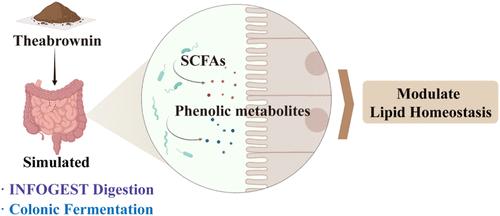益生元茶啡肽的肠道微生物分解代谢产生对肠道健康和脂质稳态具有生物活性的代谢物
IF 6.2
1区 农林科学
Q1 AGRICULTURE, MULTIDISCIPLINARY
引用次数: 0
摘要
尽管茶褐素(TB)是一种来自黑茶的聚合酚类色素,在健康代谢调节中显示出前景,但其胃肠道转化及其潜在机制仍知之甚少。在这里,我们首次采用体外消化和结肠发酵模型对TB的胃肠道分解代谢和微生物靶向生物活性进行了系统研究。结核菌在上胃肠道的生物可及性有限,但在结肠中进行了广泛的微生物转化,释放出酚类代谢产物(如类黄酮、苯丙酸),增强了抗氧化能力,增加了短链脂肪酸的产生,尤其是醋酸和丙酸。结核菌发酵通过丰富有益菌群和抑制致病菌群显著调节肠道菌群。值得注意的是,结核衍生的微生物代谢物通过下调NPC1L1和上调ABCA1抑制Caco-2细胞的胆固醇摄取。这项研究首次揭示了结核病的体外消化动力学,强调了它作为一种针对微生物群的益生元在功能食品中的脂质调节和代谢健康的潜力。本文章由计算机程序翻译,如有差异,请以英文原文为准。

Gut Microbial Catabolism of Prebiotic Theabrownin Yields Bioactive Metabolites for Gut Health and Lipid Homeostasis
Although theabrownin (TB), a polymeric phenolic pigment from dark tea, has shown promise in metabolic regulation for health, its gastrointestinal transformation and underlying mechanisms remain poorly understood. Here, we present the first systematic investigation into the gastrointestinal catabolism and microbiota-targeted bioactivity of TB using an integrated in vitro digestion and colonic fermentation model. TB exhibited limited bioaccessibility in the upper gastrointestinal tract but underwent extensive microbial biotransformation in the colon, releasing phenolic metabolites (e.g., flavonoids, phenylpropanoids) that enhanced antioxidant capacity and increased short-chain fatty acid production, particularly acetate and propionate. Fermentation of TB significantly modulated gut microbiota by enriching beneficial genera and suppressing pathogenic taxa. Notably, TB-derived microbial metabolites inhibited cholesterol uptake in Caco-2 cells via NPC1L1 downregulation and ABCA1 upregulation. This study first reveals TB’s in vitro digestion dynamics, underscoring its potential as a microbiota-targeted prebiotic for lipid regulation and metabolic health in functional foods.
求助全文
通过发布文献求助,成功后即可免费获取论文全文。
去求助
来源期刊
CiteScore
9.90
自引率
8.20%
发文量
1375
审稿时长
2.3 months
期刊介绍:
The Journal of Agricultural and Food Chemistry publishes high-quality, cutting edge original research representing complete studies and research advances dealing with the chemistry and biochemistry of agriculture and food. The Journal also encourages papers with chemistry and/or biochemistry as a major component combined with biological/sensory/nutritional/toxicological evaluation related to agriculture and/or food.

 求助内容:
求助内容: 应助结果提醒方式:
应助结果提醒方式:


